LG Electronics Bundle
Who Really Owns LG Electronics?
Unraveling the mystery of LG Electronics SWOT Analysis ownership is key to understanding this tech giant's future. From its humble beginnings as GoldStar to its current global dominance, LG's ownership structure has evolved significantly. Knowing "Who owns LG" is critical for investors, competitors, and anyone interested in the company's strategic direction.
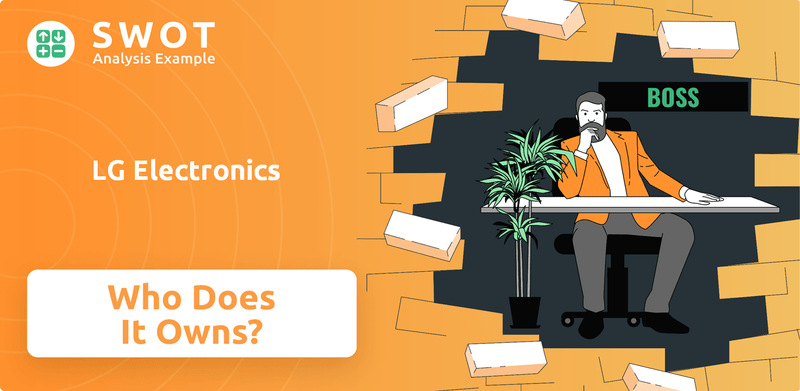
The question of "Who owns LG Electronics?" goes beyond simple stock ownership; it reveals the core of LG's operational accountability and market influence. Understanding the LG ownership structure, including LG Corporation and the LG Group, allows for a deeper dive into the company's decision-making processes and long-term vision. This article explores the history of LG ownership, its current major shareholders, and the impact of these dynamics on LG's performance and future trajectory. Is LG owned by Samsung? Find out as we explore the intricacies of this Korean company.
Who Founded LG Electronics?
The story of LG Electronics begins with its founder, Koo In-Hwoi, who established GoldStar in 1958. The early ownership of the company was firmly rooted in the Koo family, setting the stage for the evolution of what would become a global electronics giant. This family-centric approach was typical of South Korean conglomerates, or chaebols, during that era.
GoldStar's formation was part of the larger LG Group, then known as Lak-Hui Chemical Industrial Corp. and GoldStar Co., Ltd. The initial capital and operational control were primarily within the Koo family's hands. This structure allowed for long-term strategic decisions, focusing on technological advancement and market leadership without the immediate pressures of external shareholders.
Early financing for GoldStar didn't involve angel investors in the modern sense. Instead, growth was driven by internal capital and strategic investments orchestrated by the Koo family and the broader LG Group. This internal financing model shaped early agreements and strategic decisions, reflecting a family-driven vision for pioneering electronics manufacturing in Korea.
The early ownership of LG Electronics, then GoldStar, was concentrated within the Koo family, which controlled the company's direction from its inception. This structure was typical of chaebols in South Korea, emphasizing family control and long-term strategic planning.
- Founder: Koo In-Hwoi established GoldStar in 1958.
- Ownership Structure: Primarily family-owned, with control held by the Koo family.
- Funding: Internal capital generation and strategic investments from the LG Group.
- Strategic Focus: Technological independence and market leadership were key priorities.
- Legal Structure: Initially structured as part of the larger LG Group.
LG Electronics SWOT Analysis
- Complete SWOT Breakdown
- Fully Customizable
- Editable in Excel & Word
- Professional Formatting
- Investor-Ready Format
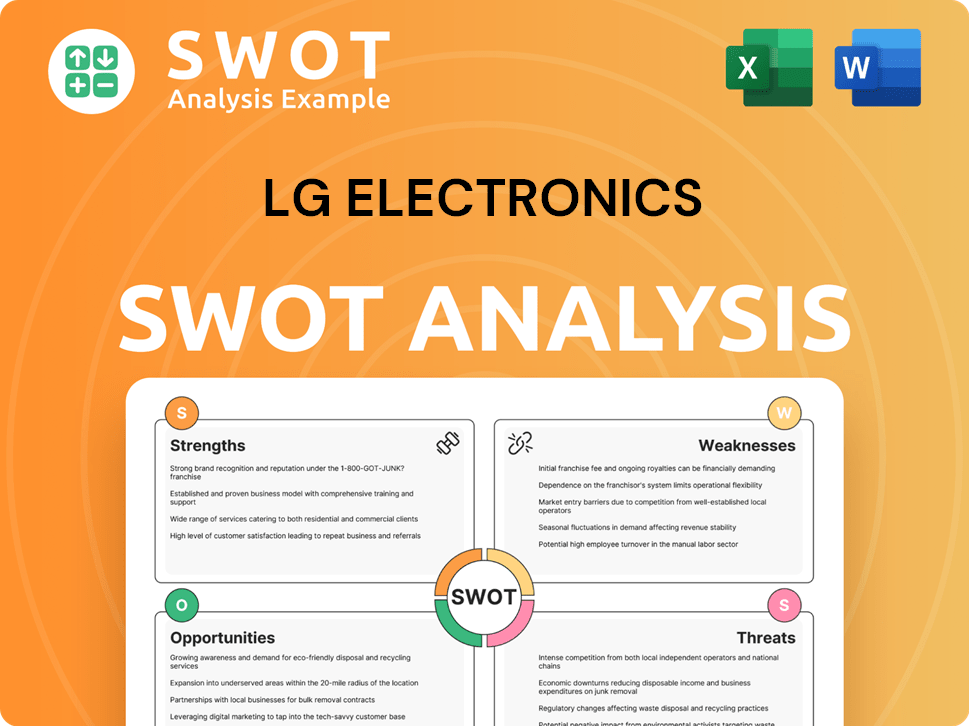
How Has LG Electronics’s Ownership Changed Over Time?
The evolution of LG Electronics' ownership reflects a transition from a family-controlled entity to a publicly traded corporation. Initially, the company operated under the control of its founding family. The decision to go public marked a significant shift, opening the door for a broader investor base and influencing the company's strategic direction. Over time, this shift has led to increased focus on shareholder value and improved corporate governance.
The ownership structure has seen changes with the rise of institutional investors. These investors, including pension funds and global asset managers, now hold substantial stakes in the company. This diversification has brought about greater scrutiny and demands for transparency, shaping the company's operational and financial strategies. The influence of these major shareholders has become increasingly important in guiding the company's future.
| Event | Impact | Year |
|---|---|---|
| Initial Public Offering (IPO) | Transition from family control to public ownership, increased investor base. | Not specified, but occurred over several decades. |
| Growth of Institutional Investors | Increased focus on shareholder value, enhanced corporate governance, and greater transparency. | Ongoing, with significant changes in the 21st century. |
| LG Corp.'s Continued Influence | Maintains the influence of the founding family, ensuring strategic alignment. | Ongoing, as of 2024. |
As of the first quarter of 2024, the primary shareholder of LG Electronics is LG Corp., the holding company of the LG Group. This highlights the continued influence of the Koo family, which controls LG Corp. Major institutional investors, such as the National Pension Service of Korea, also hold significant stakes. Furthermore, foreign institutional investors and various funds collectively own a considerable portion of the company's shares. The exact percentages held by each investor can fluctuate due to market dynamics. For more insights, check out the Revenue Streams & Business Model of LG Electronics article.
The ownership of LG Electronics is primarily split between LG Corp. and various institutional investors.
- LG Corp. (LG Group) is the largest shareholder, maintaining family influence.
- National Pension Service of Korea is a significant institutional investor.
- Foreign institutional investors also hold substantial stakes.
- This structure impacts corporate strategy, emphasizing shareholder value.
LG Electronics PESTLE Analysis
- Covers All 6 PESTLE Categories
- No Research Needed – Save Hours of Work
- Built by Experts, Trusted by Consultants
- Instant Download, Ready to Use
- 100% Editable, Fully Customizable
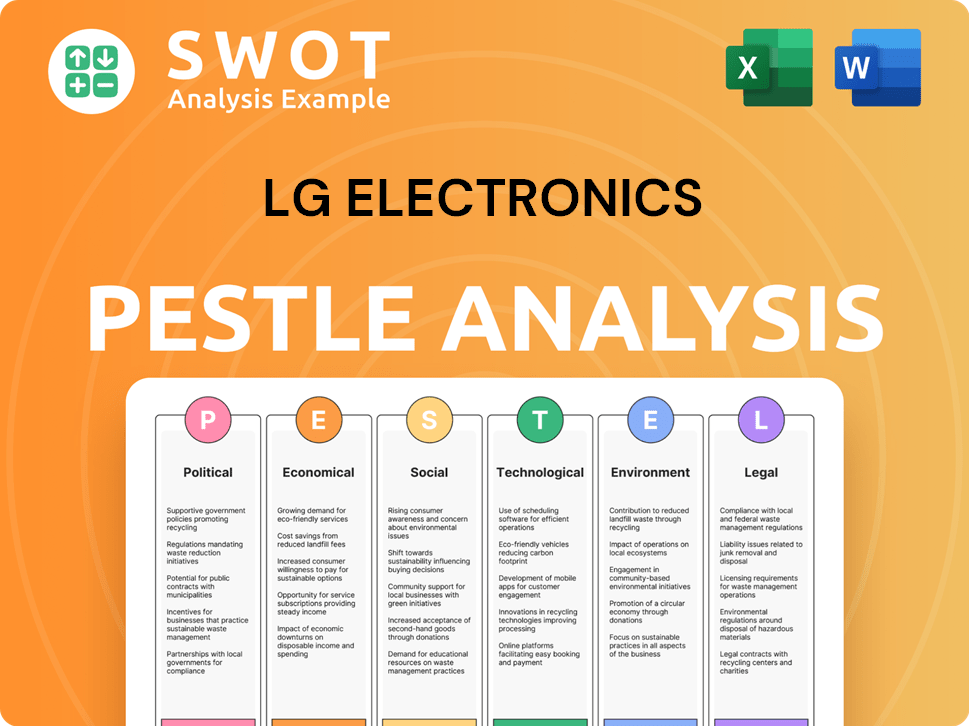
Who Sits on LG Electronics’s Board?
The current Board of Directors of LG Electronics includes a mix of executive, non-executive, and independent directors. As of early 2025, the board typically features key executives from the company itself, alongside representatives from LG Corp., the largest shareholder. Independent directors are also present to provide external oversight and ensure balanced decision-making, adhering to corporate governance best practices. This structure aims to balance internal expertise with external perspectives.
The presence of independent directors helps to ensure that the company's decisions are made in the best interests of all stakeholders. The board's composition reflects a balance between operational expertise and external oversight, which is critical for strategic planning and risk management. The board structure supports the company's long-term growth objectives.
| Director Category | Description | Role |
|---|---|---|
| Executive Directors | Senior executives of LG Electronics | Oversee day-to-day operations and strategic initiatives |
| Non-Executive Directors | Representatives from LG Corp. and other major shareholders | Provide oversight and represent shareholder interests |
| Independent Directors | External experts with no direct affiliation with the company | Offer independent perspectives and ensure governance compliance |
The voting structure of LG Electronics generally follows the one-share-one-vote principle for common shares. However, the substantial stake held by LG Corp. grants the Koo family and its affiliated entities significant voting power. This allows them to exert considerable influence over major strategic decisions, board appointments, and the company's long-term direction. The concentrated control, while providing stability, means the major shareholder's perspectives often heavily influence strategic planning and governance. For more insights into the company's strategic direction, you can explore the Growth Strategy of LG Electronics.
The board includes executive, non-executive, and independent directors. LG Corp., the largest shareholder, has significant voting power. The Koo family's influence is substantial due to their stake in LG Corp.
- Board composition balances internal expertise and external oversight.
- Voting power is largely concentrated with the major shareholder.
- Independent directors ensure balanced decision-making.
- The structure supports long-term stability and growth.
LG Electronics Business Model Canvas
- Complete 9-Block Business Model Canvas
- Effortlessly Communicate Your Business Strategy
- Investor-Ready BMC Format
- 100% Editable and Customizable
- Clear and Structured Layout
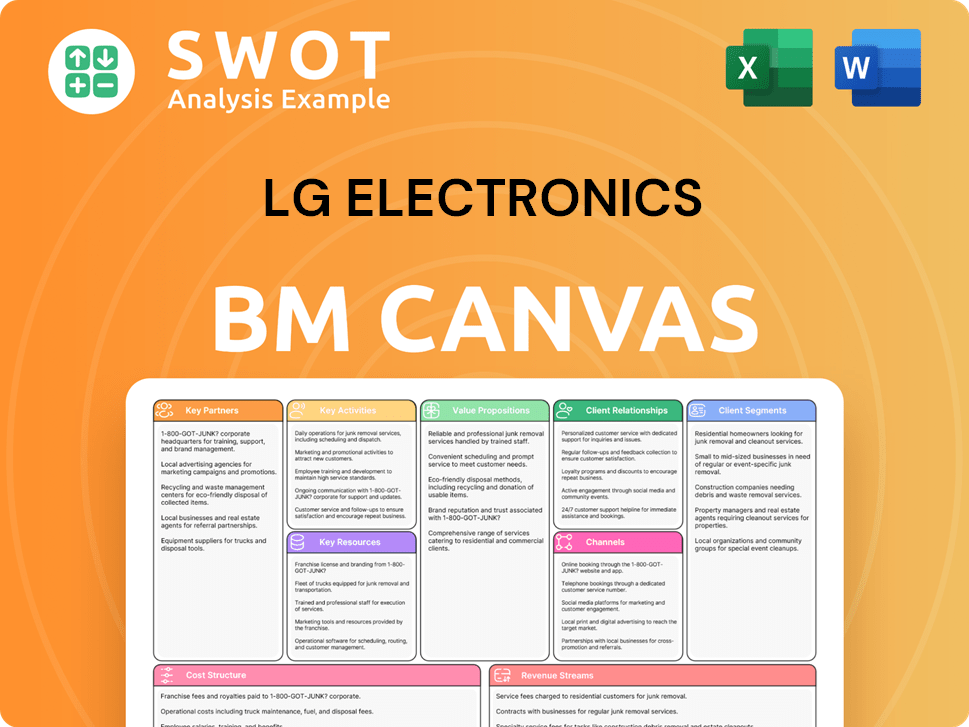
What Recent Changes Have Shaped LG Electronics’s Ownership Landscape?
Over the past few years (2022-2025), the ownership structure of LG Electronics has remained relatively stable, with no significant shifts in control. The primary shareholder remains LG Corp., the parent company, ensuring continued family influence. However, there have been subtle changes in institutional holdings, reflecting broader market trends and investor sentiment influenced by LG Electronics' strategic moves.
The company's exit from the mobile phone business in 2021, for instance, has reshaped investor focus. Investors are now reevaluating the company's future prospects, especially in areas like home appliances and vehicle components. The company's commitment to innovation and sustainability is also attracting specific types of investors. These shifts are reflected in the adjustments made by large asset managers and pension funds in their stakes.
| Ownership Category | Approximate Percentage (Early 2025) | Notes |
|---|---|---|
| LG Corp. | Varies, but a significant controlling stake | Ensures family influence and strategic direction. |
| Institutional Investors | Varies, but generally a substantial portion | Includes asset managers, pension funds, and other institutional investors. |
| Public Float | Remaining Percentage | Shares available for public trading. |
Industry trends show an increase in institutional ownership globally. Public statements and analyst reports often highlight LG Electronics' performance in its core businesses and its expansion into new areas like electric vehicle components and digital health, which attract specific types of investors. Any potential changes within the broader LG Group or LG Corp. holding could indirectly affect LG Electronics' ownership perception, although no major announcements were made as of early 2025. Strategic buybacks or secondary offerings, if any, would focus on optimizing capital structure and shareholder value. For more information on the company's overall strategy, consider reading this detailed analysis of LG Electronics' performance and market position.
LG Electronics is primarily controlled by its parent company, LG Corp. Institutional investors also hold a significant portion of the shares. The ownership structure reflects a blend of family influence and public market participation. This structure provides stability while allowing for public market investment.
The major shareholders of LG are LG Corp. and various institutional investors. The exact percentage held by each can fluctuate based on market activity. Understanding the shareholder base is important for assessing the company's direction.
Yes, LG Electronics is a publicly traded company. Its shares are available on the stock market. This allows investors to buy and sell shares, reflecting market sentiment.
LG Corp. plays a crucial role in shaping LG Electronics' strategic decisions. The parent company's influence ensures long-term vision and stability. This relationship is vital for the company's direction.
LG Electronics Porter's Five Forces Analysis
- Covers All 5 Competitive Forces in Detail
- Structured for Consultants, Students, and Founders
- 100% Editable in Microsoft Word & Excel
- Instant Digital Download – Use Immediately
- Compatible with Mac & PC – Fully Unlocked
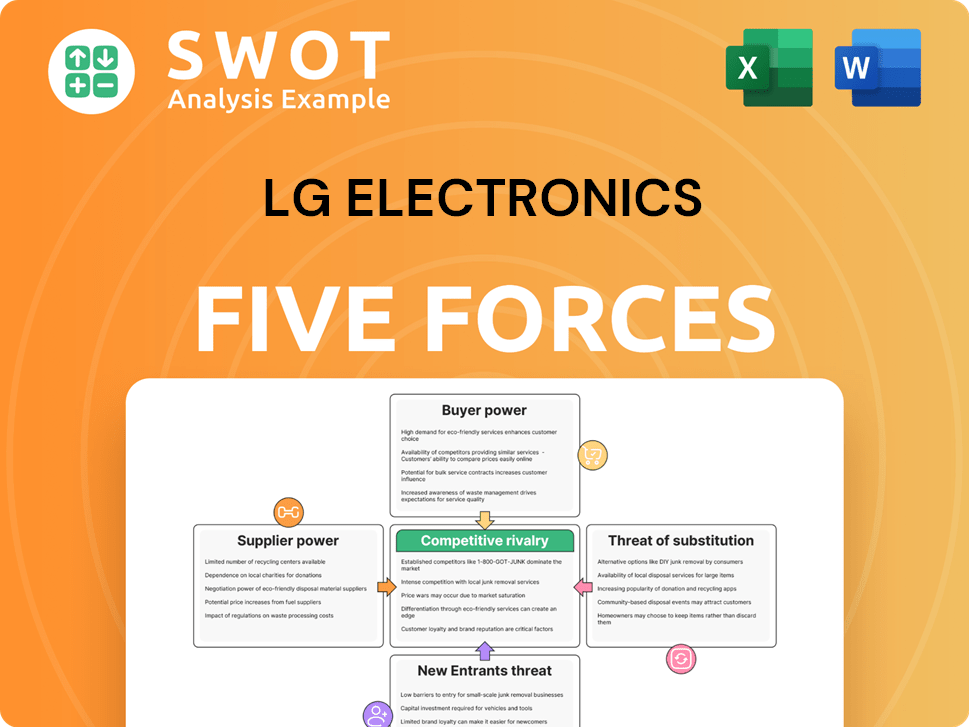
Related Blogs
- What are Mission Vision & Core Values of LG Electronics Company?
- What is Competitive Landscape of LG Electronics Company?
- What is Growth Strategy and Future Prospects of LG Electronics Company?
- How Does LG Electronics Company Work?
- What is Sales and Marketing Strategy of LG Electronics Company?
- What is Brief History of LG Electronics Company?
- What is Customer Demographics and Target Market of LG Electronics Company?
Disclaimer
All information, articles, and product details provided on this website are for general informational and educational purposes only. We do not claim any ownership over, nor do we intend to infringe upon, any trademarks, copyrights, logos, brand names, or other intellectual property mentioned or depicted on this site. Such intellectual property remains the property of its respective owners, and any references here are made solely for identification or informational purposes, without implying any affiliation, endorsement, or partnership.
We make no representations or warranties, express or implied, regarding the accuracy, completeness, or suitability of any content or products presented. Nothing on this website should be construed as legal, tax, investment, financial, medical, or other professional advice. In addition, no part of this site—including articles or product references—constitutes a solicitation, recommendation, endorsement, advertisement, or offer to buy or sell any securities, franchises, or other financial instruments, particularly in jurisdictions where such activity would be unlawful.
All content is of a general nature and may not address the specific circumstances of any individual or entity. It is not a substitute for professional advice or services. Any actions you take based on the information provided here are strictly at your own risk. You accept full responsibility for any decisions or outcomes arising from your use of this website and agree to release us from any liability in connection with your use of, or reliance upon, the content or products found herein.